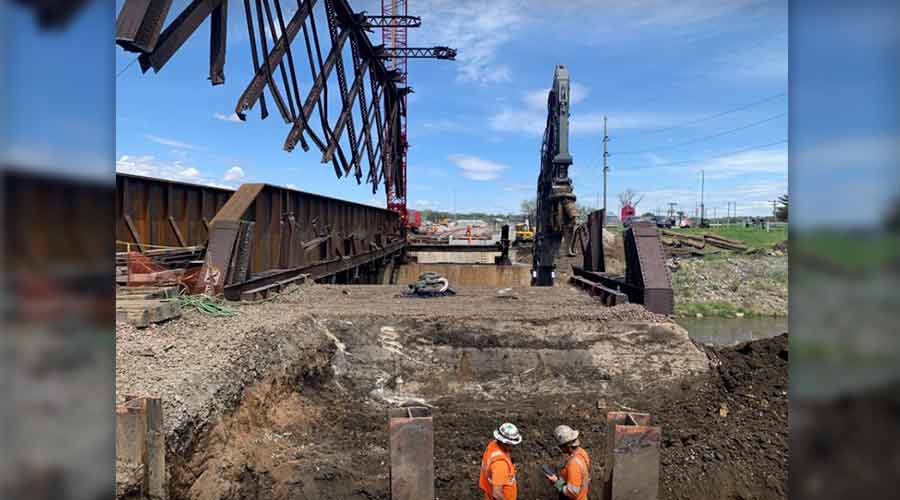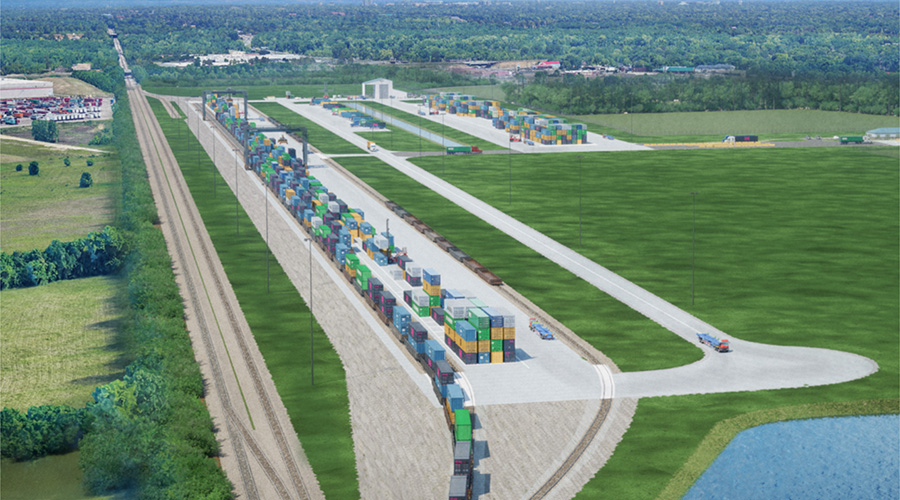UP: Taking on outdated bridges for today’s, tomorrow’s operational needs
6/21/2022
By Jeff Stagl, Managing Editor
Time has caught up to Union Pacific Railroad’s bridge in Elkhorn, Nebraska. Located in the Class I’s Omaha Subdivision, the key structure dates back to 1906.
So, UP is advancing a major effort to replace the 116-year-old bridge. But time also is a big factor in those plans. Since it takes about six years to complete a bridge’s design, steel fabrication and construction, work on the Elkhorn structure is not expected to start until 2024.
For now, UP is focusing on steel fabrication. The Class I’s supply department recently contracted PVS Structures (formerly known as Paxton Vierling Steel) as the project’s fabricator. PVS has fabricated many bridges for UP in the past.
 The railroad plans to build a deck-plate girder bridge off line on a new alignment to avoid service interruptions, and in a new location because of river shifts. Union Pacific Railroad
The railroad plans to build a deck-plate girder bridge off line on a new alignment to avoid service interruptions, and in a new location because of river shifts. Union Pacific RailroadThe new deck-plate girder bridge will require 2,100 tons of steel. It will feature six double-wide spans to accommodate two tracks, with each span stretching 130 feet in length. The fabricated steel will be delivered to the site on flat cars. PVS is served by both UP and CN.
The bridge is located along UP’s main transcontinental route. Over the past several years, a number of service interruptions associated with the structure’s weakening condition have disrupted traffic. The new bridge will eliminate service issues, UP officials said in an email.
“Service [will be] less variable. This is another investment … to help make our service product more reliable, and thus more valuable, for our customers,” said Adam Studts, UP’s senior manager of structures design. “Investing in new bridges, rail, ties, facilities and technology is critical to [our] ability to maintain a safe and reliable rail network.”
The new bridge will be built according to modern and safer construction standards. Safety enhancements will include a higher load limit, deeper foundations, improved hydraulic performance and redundant structural systems, said Studts.
The new structure will feature weathering steel, an alloy designed to enable a patina to form and greatly reduce corrosion. The stronger steel can better stand up to varying weather conditions, maintain a structure for up to 100 years and maximize a bridge’s efficiency, UP officials say.
In addition to its advancing age, the bridge needs to be replaced because of changes in the surrounding landscape. Over the past 115 years, the Elkhorn River has shifted eastward.
“The main river channel at one time was under the truss span at the west end of the bridge, but slowly moved to its present location nearer to the east end of the bridge,” said Studts. “The bridge piers where the river channel is today were not built as deep in the ground as the piers to the west.”
 UP crews recently replaced a 110-year-old bridge in Denison, Iowa, in 30 hours instead of in several weeks or months. Union Pacific Railroad
UP crews recently replaced a 110-year-old bridge in Denison, Iowa, in 30 hours instead of in several weeks or months. Union Pacific RailroadCrews will underpin and strengthen the piers multiple times to make them more stable during periods of high river flow. The new bridge will be erected in a different location because of the evolving river, and will be built off line on a new alignment to avoid service interruptions and train delays.
Meanwhile, UP crews recently replaced a 110-year-old bridge in Denison, Iowa, in 30 hours instead of in several weeks or months. The structure over the East Boyer River long had been a 170-foot-long, double-track bridge with a through-truss span.
The new 203-foot-long, double-track bridge features a through-plate girder span and structural steel that surrounds a train as it crosses over, much like a tunnel. The through-plate girder has no structural steel hanging over the top of a train to prevent overhead clearance issues.
The new bridge will help sustain train velocity by reducing maintenance needs, said Chris Gust, UP’s director of bridge maintenance and construction-engineering.
To complete the project in a matter of hours, crews used multiple cranes, including a tall, 650-ton model that helped with demolition and heavy lifting tasks. The new main span was more easily slid into place using heavy-duty jacks and rollers, and newly built track was more quickly surfaced with numerous tampers and ballast regulators.


